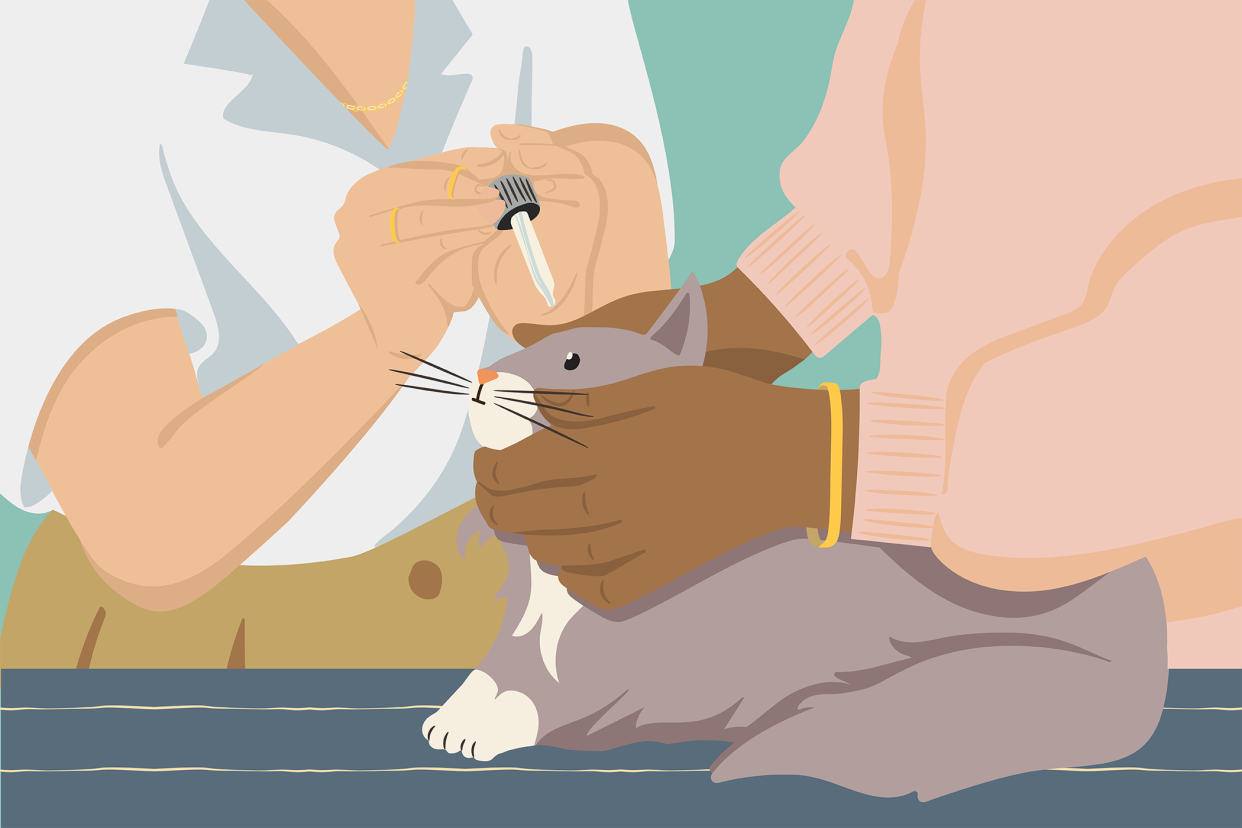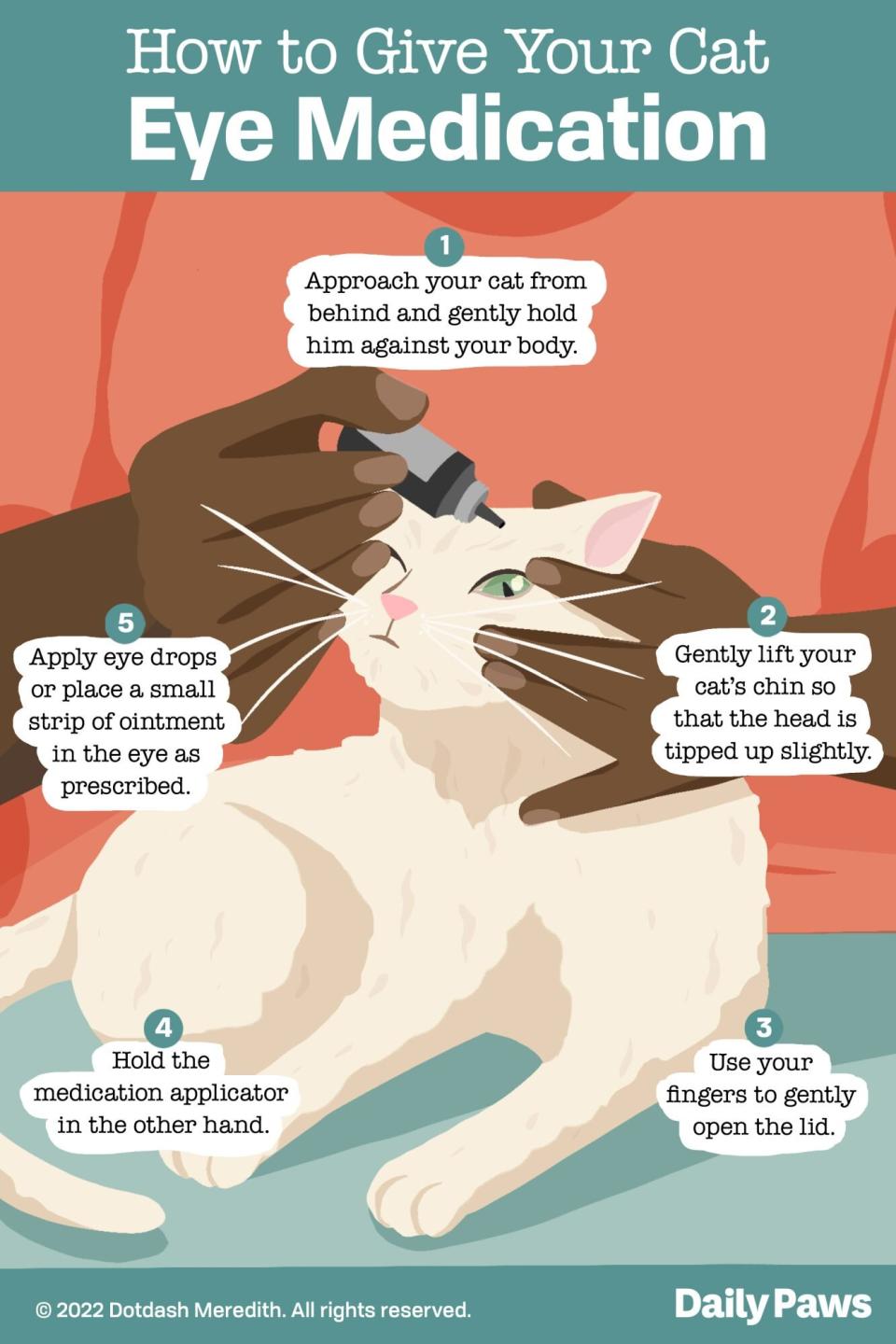Why Your Cat Might Need Eye Drops and How to Administer Them (Without Losing a Hand)

Grace Canaan
If your cat has been prescribed eye drops, you might be thinking you need to prepare for battle. But with the help from a friend and some expert kitty burrito (aka purrito) wrapping skills, Sarah Machell, DVM, Medical Director of Vetster says giving your cat eye drops doesn't have to be that bad.
"Your cat's eyes should be clear and bright," Machell says. "If they are leaking, oozing, red, puffy, or cloudy, it's time to speak with your veterinarian to get to the bottom of the cause." When it comes to your cat's eyes, here's what to look out for and how to administer eye drops if prescribed by your vet.
When Do Cats Need Eye Drops?
"The most common reasons for the application of eye drops to cats is to aid in the treatment of eye infections caused by viruses or bacteria, or to assist in the healing of abrasions or scratches to the cornea of the eye," Machell explains. "Occasionally, eye drops may also be required to add moisture and lubrication to an eye that has been diagnosed with a condition known as dry eye." Here's a quick overview of what those conditions can look like in your cat.
Eye Infections
Like Machell mentioned, an eye infection can be viral or bacterial. The symptoms of an eye infection can look quite similar to an eye infection in a human: redness in the whites of the eyes, clear, yellow, or green discharge, and/or excessive blinking or a funny-looking wink. You might notice that your cat's third eyelid is covering more of her eye than usual and if the eye infection is related to an upper respiratory infection, she could be sneezing or have nasal discharge.
RELATED: Could Your Cat Have Pink Eye?
Abrasions or scratches
A scratch to a cat's eye is also called a corneal erosion or corneal abrasion and is usually caused by trauma like a run-in with a torn, a rouge particle of dust, or another cat's claw. It can also be a chemical trauma, like an irritating shampoo or household chemicals. An abrasion can be painful for your cat and she'll likely be found rubbing her eyes with her paws, against the couch, or on the carpet. You might also notice some discharge.
Dry Eye
Technically speaking, dry eye, or keratoconjunctivitis sicca, is the inflammation of the cornea and surrounding tissues from dryness. AKA, your cat isn't producing enough tears and likely has red, painful, and irritated eyes.
Glaucoma
More common in dogs than in cats (with the exception of Burmese and Siamese breeds), glaucoma is caused by the imbalance of production and drainage of the fluid within the eye. Early signs of glaucoma include cloudiness of the eye, which increases in severity with time. Other signs include enlargement of the affected eye(s), squinting, and dilation of the pupil.
RELATED: Everything You Need to Know About Cat Cataracts
Allergies
Cats might need eye drops for allergies too. Like us, allergies can cause red, itchy eyes with discharge. But keep reading before considering sharing your Clear Eyes with your cat.
If your cat is showing any signs of these common eye conditions or has any other changes in behavior or appearance, it's best to consult your vet. "Regardless of an eye drop being a prescription or an over-the-counter medication, a discussion with a veterinarian should be had before applying anything to your cat's eyes," Machell says.

Kailey Whitman
How to Give a Cat Eye Drops Step-by-Step
You are not alone if you're wondering how best to get those vet-prescribed drops into your cat's eyes. We've gathered up a few tips from trusted vets to make this process easier. However, it's always a good idea to ask your vet for tips when your drops are prescribed and they might even show you how to administer them.
1. Preparation
Locate your kitty. If she knows the sound of the drawer where her meds are kept, she might make a run for her favorite hiding place. "Cats quickly learn the routine of medication," Laura Robinson, DVM, lead veterinary advisor for Pawp says. "I recommend continually switching around where you keep the medication."
2. Ready Yourself, Your Cat, and a Friend
Administering eye drops is usually a two-person job, Machell says. One person should be ready to administer the drops while the other holds and comforts the cat. "As a rule of thumb, the shorter the interaction, the better the success rate in getting the drop applied. However, some cats will not stay still long enough to permit this happening without some type of gentle restraint," Machell says. If this sounds like your kitty, Machell suggests a kitty purrito, or using a towel or blanket to wrap your cat up—like a little kitty burrito. A quick interaction also means knowing exactly how many drops your cat needs before she's in position.
3. Administering the Eye Drops
"It is always best, unless advised otherwise by your veterinarian, to attempt to apply eye drops directly to the surface of the eye, dropping the medication from a short distance above the open eye, avoiding touching the eye drop container to the eye tissues whenever possible," Machell says. To do this, Machell recommends:
Placing your kitty in your lap facing away from you, toward the person administering the drops;
The person administering the drops should gently wipe her eye with a damp cloth to clear any debris;
The person administering the drops should lift the cat's head slightly, dropping the medication into the eye while gently resting their hand on the cat's head.
"If your cat is extremely independent and very difficult to medicate, have a conversation with your veterinarian about the possibility of additional medication strategies that may make the process less stressful for all," Machell recommends. It's important to mention to your vet if your cat is showing any signs of pain—a cuddly floof could become aggressive when she's feeling hurt and in distress.
RELATED: How to Give a Cat Liquid Medicine
Can You Use Human Eye Drops on Cats?
Machell says to think twice, then call your vet before sharing your human eye drops with your cat. Some cat eye drops contain the same agents as human eye drops, but others have ingredients known to cause adverse effects—including anaphylactic reactions. Remember, Machell says, your cat's eyes are very delicate and non-replaceable, so always consult your vet about their care.

